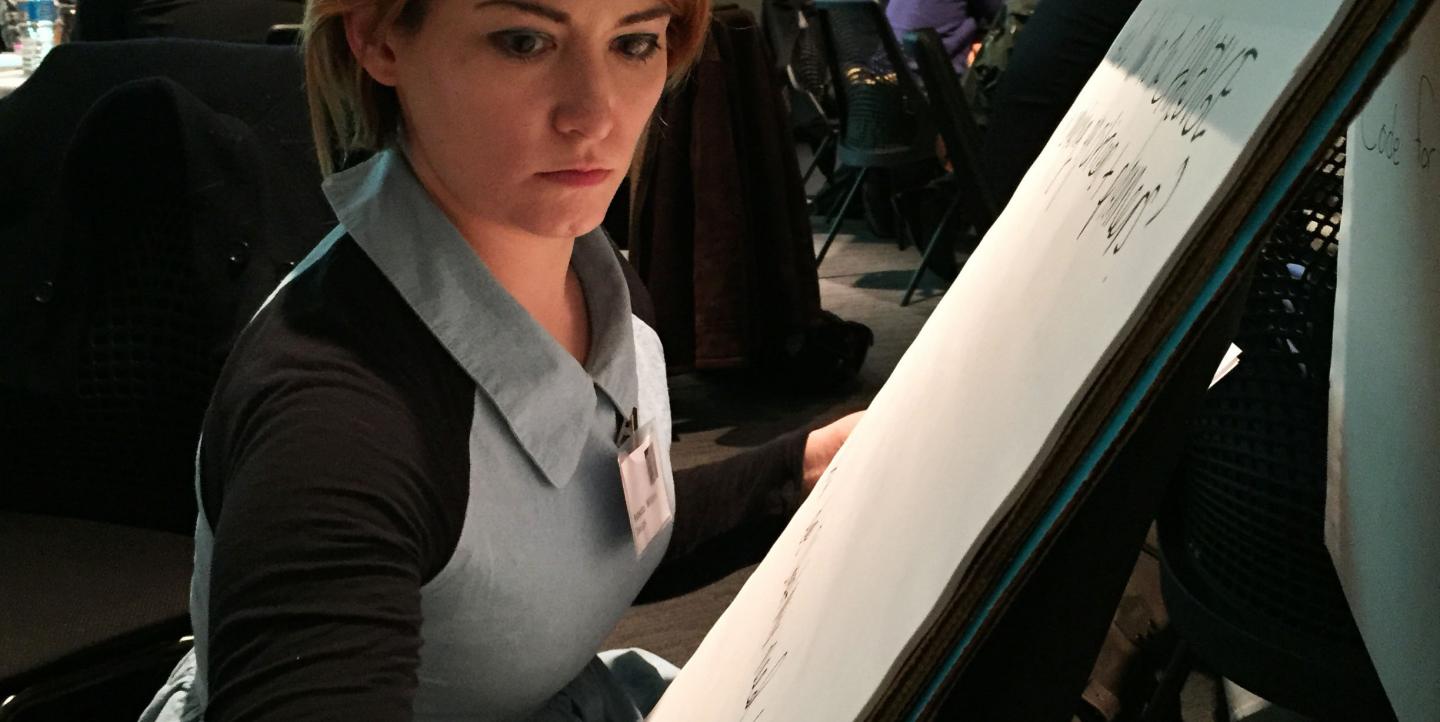PBS MediaShift's Collab/Space, a workshop that brings together everyone from journalists to academics to developers, has already been to New York City and Chicago. In New York, participants focused on intrapreneurial projects within newsrooms. In Chicago, MediaShift brought together media startups.
But for Collab/Space DC, it was all about data, and dissecting the tools that have evened the playing field.
“Why are people talking about data now?” PBS MediaShift Executive Editor Mark Glaser asked. “It’s been around forever, but now the tools have caught up to the data."
Eight teams presented their data innovation projects to a room full of people ready to critique each one. Every team had five minutes to explain their project. Questions from the audience and advice from media strategist Brian Reich helped shape the main challenges each team faced. After the presentations, participants got into groups with project leads to brainstorm solutions to the challenges identified.
Most groups faced the same questions news outlets do: How can I make my tool profitable? Who’s the best audience? How do we reach out to them with our tool?
As Reich noted, all the tools presented at Collab/Space DC “are presumably going to change how we tell stories.”
And who better to tell stories with these tools than journalists? Here are tips media professionals gave the development teams that news organizations dipping into data can benefit from too.
Find the right audience before going big.
MapStory allows users to input data and create visualizations, a tool with a lot of potential for journalism. A crime reporter could make a map of where U.S. prisons opened between 1811 and 2004. A journalist covering the culture beat could create a map of how many Latino murals in Washington, D.C., have disappeared since the 1970s.
There are so many possibilities journalists – or anyone with an idea – could map out that it might be difficult to know where to start.
“Go narrow and go local,” Ryan Sholin of Gannett Digital said. “Take cities where people embrace change, are forward-thinking and have an issue they want to solve.”
Tap into local trends.
The Sunlight Foundation's Open Civic Data Project allows everyday citizens to upload information about their towns, local governments and schools. But similarly to MapStory, there's a lot of data and only so many people who want to spend their spare time inputting it.
Reich told the team to think about some issues that were trending more than others.
"If gun [control] is more popular, why not focus on that data set?" Reich asked. "It's a way to help accelerate the project beyond the people who are already interested."
Make efforts to work with other organizations, even when it’s difficult.
A laborious team at The Washington Post is in the process of developing a crime database using police blotters in Washington. The database is meant to help the Post team create better graphics depicting crime trends.
But the team encounters resistance from some police departments, said Denise Lu, local graphics coordinator and data editor at the Post. Not only are some departments hesitant to provide the data, but they might provide lists of incidents on PDFs or poorly made spreadsheets.
Lu and software engineer Peter Pezon asked police departments to send data in specific ways so the Post could more easily upload the information to the database, but few did.
Ingrid Sturgis, an assistant professor of new media at Howard University, suggested the Post use its database to show police departments how it can help their officers too.
“It’s a way to acknowledge the police organization’s efforts,” Sturgis said.
Make your data accessible and understandable.
At the beginning of the Ebola outbreak, the World Health Organization approached Development Seed with a data collection problem: There were huge gaps of information.
People who had data about Ebola didn’t know how to use it, and people who could’ve benefited from the data didn’t have access to it.
Development Seed created WHO’s Ebola Data Portal by taking loose-leaf PDFs and maps and creating an interactive graphic with the information. Though the company’s CEO Ian Schuler said they’re still grappling with how to keep the data up to date, it’s also a big project with a lot of “heavy speak.”
“Make it understandable so you can use it on CNN or other news organizations,” Reich said.
“Make it multiplatform,” Meredith Broussard of Temple University said, suggesting people use the data portal in countries with Ebola outbreaks to do radio broadcasts with the information or offer daily data reports using artificial intelligence.
Make your project open source.
The more to build off, the better.
“The more organizations that unilaterally put [tools] out allows us to see how others have done it,” Schuler said.
News organizations interested in how U.S. News & World Report is tracking potential 2016 presidential candidates can see how they’ve done it on GitHub.
“People can steal all our graphs,” data reporter Lindsey Cook said, “but our logo's on it. We may not be getting the clicks to our site, but we’re getting the exposure.”
If any of the tools seem useful to your town, news organization and beyond, reach out to the developers behind the tools. We’ve listed the available Twitter handles of presenters at Collab/Space DC below.
MapStory: @jonpmarino
The Washington Post's Crime database: @DeniseDSLu and @pezondispenser
WHO's Ebola Data Portal: @IanSchuler and @developmentseed
Presidential Tracker: @Lindzcook and @ASoergel
Code for America's Streetmix: @saikofish
Gannett's Harvest for Change: @anthonydb
Fiscal Note: @JohnZoshak and @fiscalnote
Open Civic Data Project: @stereogab and @jamesturk

